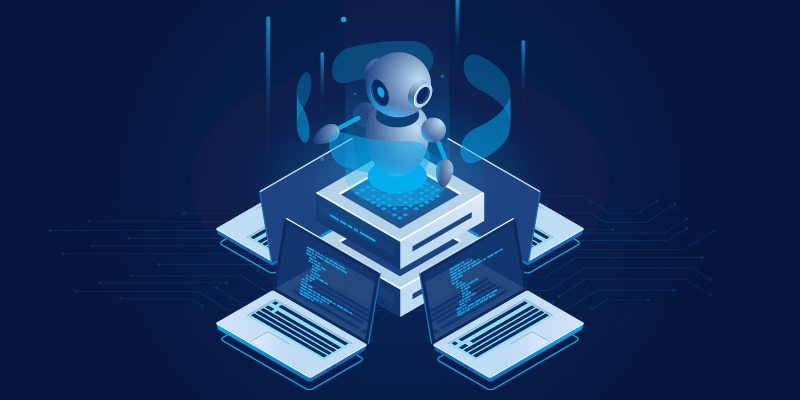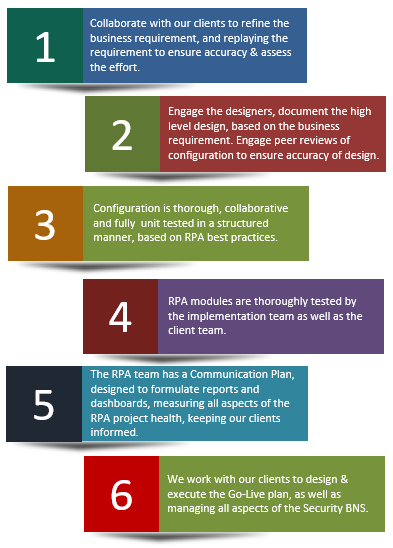Difference between revisions of "Robotic Process Automation"
| Line 2: | Line 2: | ||
==What is Robotic Process Automation?== | ==What is Robotic Process Automation?== | ||
| − | Robotic Process Automation (RPA) describes software tools that partially or fully automate manual, rule-based, | + | Robotic Process Automation (RPA) describes software tools that partially or fully automate manual, rule-based, tasks considered redundant in the modern workplace. RPA software robots (a.k.a. digital workers or bots) follow rule-based processes along an If/Then programming path to mimic existing business processes and tasks of human workers, such as: data entry, standard transaction processing, or responding to customer service questions. |
| − | + | RPA leverages data and automation to modernize business processes within existing operational ecosystems. RPA processes involve documentation of existing processes and tasks associated with business processes and aim to integrate within current workflow to support operational efficiency and modernize the workforce to enable innovation. RPA bots are programmed to imitate certain rule-based and repetitive tasks using their own unique login information that is monitored by human controllers. As the RPA bots enable integration within existing business processes and IT infrastructure, it is an ideal tool to modernize workflow through automation of outdated business processes. | |
[[File:RPA1.png|alt=|376x376px]] | [[File:RPA1.png|alt=|376x376px]] | ||
Revision as of 14:46, 7 September 2022
What is Robotic Process Automation?
Robotic Process Automation (RPA) describes software tools that partially or fully automate manual, rule-based, tasks considered redundant in the modern workplace. RPA software robots (a.k.a. digital workers or bots) follow rule-based processes along an If/Then programming path to mimic existing business processes and tasks of human workers, such as: data entry, standard transaction processing, or responding to customer service questions.
RPA leverages data and automation to modernize business processes within existing operational ecosystems. RPA processes involve documentation of existing processes and tasks associated with business processes and aim to integrate within current workflow to support operational efficiency and modernize the workforce to enable innovation. RPA bots are programmed to imitate certain rule-based and repetitive tasks using their own unique login information that is monitored by human controllers. As the RPA bots enable integration within existing business processes and IT infrastructure, it is an ideal tool to modernize workflow through automation of outdated business processes.
Purposes Served by RPA
- Automates routine and repetitive tasks to reduce the human workload and allows for time to be allocated to more meaningful work.
- Liberates humans from monotonous, low-value-added work that does not contribute to growth, and reduces human error.
- Helps to ensure that outputs are complete and correct.
- Helps to ensure that tasks can be completed more quickly.
- They work by replicating the actions of an actual human interacting with one or more software applications to perform tasks such as data entry and processing standard transactions.
RPA Benefits Compared to Traditional Methods
Robotic Process Automation
|
Other Tools
|
The Digital Services Branch - Pay Solutions and RPA Technology
Currently, the Digital Services Branch - Pay Solutions (DSB-PS) uses Robotic Process Automation (RPA) technology for the Front Office (FO) to process pay solutions and business processes by implementing a secure, agile, and smart digital workforce to reinstate trust with government employees and the public.
Since November 19th, 2020, the DSB-PS FO successfully deployed four pay processes into production for the Pay Centre. As of August 10th, 2022, the digital workers have processed over 76,900 pay transactions and has saved Compensation Advisors (CAs) over 21,250 total processing hours.
Due to the successes of the first four processes, the DSB-PS is planning to release two additional pay process in late August and has many more pay processes in the pipeline. The DSB-PS is constantly working with different departments (i.e., Pay Centre, Human Resources, Unions, etc.) to determine ways to implement RPA solutions and processes that mitigate potential human error, improve process accuracy, help streamline functional operations, and help government employees by reallocating their human effort to other pay critical areas.
An important detail to note, digital workers can work 24/7 and don't take breaks, whereas CAs typically work 8 hours a day with regularly scheduled breaks. By automating the simple tasks and transactions of CAs, it allows them to focus their attention and time on more complex cases that require human validation.
As government employees realize that digital workers and RPA cannot replace human employees but is instead a useful tool to streamline productivity, they develop trust and fears decline.
Software Landscape
Development and Deployment
|
Readability of a Process
|
System Integration
|
Integration with Other Applications
|
RPA Project Delivery Framework
Below is an illustration of the RPA project delivery framework lifecycle – all of the DSB-PS RPA initiatives are to adhere to each of the elements of the Software Development Life Cycle (SDLC) framework model in order to produce quality deliverables and ensure the excellence of delivery.





